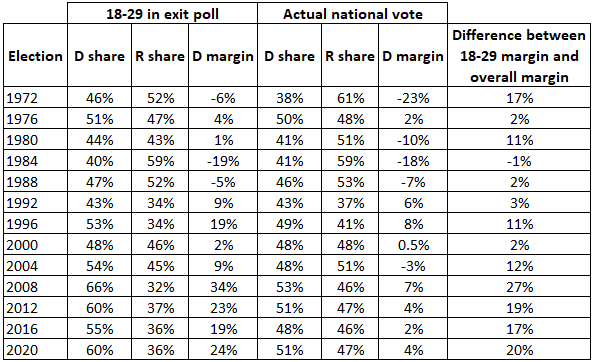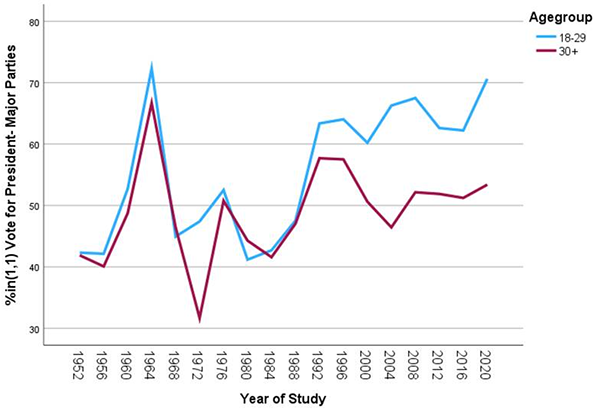Putting Biden’s Troubles with Young Voters in Perspective
A Commentary By Kyle Kondik
Youngest voters have been strongly Democratic in recent elections, but the president also has clear weaknesses with that group.
KEY POINTS FROM THIS ARTICLE
— Recent 2024 presidential polling has shown President Biden performing poorly with young voters.
— The 18-29 voting bloc has been reliably Democratic leaning for at least the last several presidential elections.
— Biden’s weakness with young voters is not new, despite doing well among the group in the 2020 general election.
A brief history of young voters in presidential elections
Polling this far out from a presidential general election is often not predictive, and it is a good thing for President Joe Biden that this is the case, because his polling right now against his most likely general election opponent, former President Donald Trump, is poor.
Trump has led Biden in most recent national surveys included in the RealClearPolitics average of national polls, with Trump leading by about 2 points in the average.
One of the features of many (though not all) of these polls is striking weakness for Biden among what has become a very Democratic-leaning group of voters: 18-29 year olds. In 2020, Biden defeated Trump among the 18-29 group by roughly 25 points, according to the 2020 exit poll conducted by Edison Research for a variety of news organizations, a different exit poll from NORC at the University of Chicago conducted for the Associated Press and Fox News, and a post-2020 analysis by the Democratic firm Catalist. So it is a bit jarring to see Trump competitive with or even leading Biden among the youngest voters in polls (defined in some polls as 18-29 and others as 18-34). But that is indeed what many of these polls show.
There has been an ongoing debate about what to make of these poll findings. To get a flavor of the arguments, see these recent pieces from Nate Cohn of the New York Times, which released polling showing Biden trailing Trump in nearly all of the key swing states and found weakness for Biden among young voters, and from Natalie Jackson, a Center for Politics scholar and a vice president of the Democratic polling firm GQR Research writing in National Journal. They both make good arguments: Jackson rightly notes that young voters are very difficult for pollsters to reach and that it’s possible there may be a nonresponse bias happening right now, in which Democratic young people may be even harder to reach for a variety of reasons. Cohn, meanwhile, notes that the young people the New York Times/Siena College polls did reach appear to otherwise be representative (they reported backing Biden by a little over 20 points in 2020, similar to what those previously-mentioned analyses suggested) but are uniquely sour on Biden. We recommend reading both pieces.
One good reason to be skeptical of the current numbers is that young voters have been very Democratic-leaning in recent elections, as noted above, although this demographic feature of presidential voting is not necessarily as long-running as perhaps commonly believed.
Table 1 uses national exit poll data to compare voting among 18-29 year olds to the actual results from 1972-2020. This is a convenient timeframe because 1972 was the first election when 18-20 year olds could vote following the ratification of the 26th Amendment.
Table 1: Young voters in presidential elections, 1972-2020
Note: Percentages all rounded except in the Democratic popular vote margin for 2000, given that the margin was only half a point in favor of Al Gore.
Source: New York Times for exit polls from 1972-2008 and 2012; CNN for 2016 and 2020.
Notice that in several elections from 1972-1992, there was not that much difference between the youngest voters and the rest of the electorate. It is true that losing Democratic nominee George McGovern did markedly better with young voters than the overall electorate in 1972, but he still lost the group to Richard Nixon in the first election where the youngest adults could participate. According to these numbers, the age gap did not really swell until 2008, when Barack Obama rode a huge margin with youth voters to turn in the best overall performance of any Democratic presidential candidate in this 1972-2020 span. That gigantic Democratic edge did not endure in 2012-2020, but Democratic presidential nominees did win the 18-29 group by roughly 20 points or more in that trio of elections. (It’s also worth remembering that the actual population of those in the 18-29 group constantly changes from election to election as people age in and out of the group.)
We wanted to look at additional data to compare with this exit poll information. With that in mind, we asked our Crystal Ball Senior Columnist Alan Abramowitz to look at the American National Election Studies, a long-running academic survey of the electorate, and see how it reflects these age differences. Figure 1 goes back further — to 1952, or before those aged 18-20 could vote — and contrasts how Democratic those aged 18-29 voted compared to those aged 30 and above. Just as a note, this uses the two-party vote, whereas the results reported in Table 1 uses the all-party vote.
Figure 1: Youngest voters versus rest of electorate, 1952-2020
Source: American National Election Studies cumulative file; figure provided by Alan Abramowitz
While there are some differences between what the exit polls found and what the ANES found, they tell similar stories: Young voters have leaned Democratic relative to older voters for at least the last several presidential elections. The increasing racial diversity of the youngest cohort has likely played a role in this trend, given that nonwhite voters tend to be more Democratic-leaning.
It seems reasonable to question whether young voters would swing wildly toward Donald Trump in 2024 after he did so poorly amongst that group in 2016 and 2020 — after all, there has not been a general election campaign yet. It would also be in line with recent history for a young voting cohort that is overall very liberal on the issues to eventually also back the Democratic presidential nominee to a much larger degree than what some polls show now.
However, there are many signs that Biden, the oldest president ever and someone who does not come from the progressive wing of the Democratic Party, is hardly a good fit for the youngest voters. According to the available exit polls from the 2020 primary season, Biden generally won paltry shares of the 18-29 bloc, finishing well behind his top rival, Sen. Bernie Sanders (I-VT), even in states that he won handily, like South Carolina. There were 15 states with Democratic primary exit polls in 2020 that had results for the 18-29 group, as compiled by CNN; Biden won the 18-29 group only in Mississippi, a state where Biden won 81%-15% overall against Sanders (that primary was held a week after Super Tuesday, when Biden had grabbed the reins of the nominating contest following a slow start in the kickoff states). Biden won 61%-35% among the 18-29 group in Mississippi; he did not surpass 30% among that group in any other state that had an exit poll, and his support from the youngest voters was minuscule in many places, like in Super Tuesday megastates California (just 6%) and Texas (12%). Biden still won many of these states (including Texas), but it’s clear that the youngest voters would have preferred a different nominee. To the extent Biden shows weakness in his renomination bid, we would expect protest votes to disproportionately come from younger voters (this is something to monitor during the primary season). This primary weakness didn’t prevent Biden from doing well with young voters in the 2020 general election, but it is an indicator that Biden’s softness with young voters is not new.
Biden’s approval with young Americans has also been weak. Back in the spring, one of the top sources of information on young voters — the Institute of Politics at Harvard Kennedy School — found Biden’s approval rating at only 36% with 18-29 year olds. A possible contributor to Biden’s weak standing with these voters may include the economy and inflation — the aforementioned New York Times polls of swing states found that among 18-29 year olds who supported Biden in 2020 in these states, just 11% thought the economy was “excellent” or “good,” compared to 89% who said the economy was “poor” or “only fair.” This was a more pessimistic economic view than older cohorts of 2020 Biden supporters. Other potential contributors could be Biden’s unsuccessful effort to forgive some student debt for tens of millions of Americans and, more recently, how Biden has handled the aftermath of the Hamas strike on Israel in early October (young people are likelier than the broader public to sympathize with the Palestinians instead of Israel).
Our own two cents is that we really doubt Trump would beat Biden with young voters, or even come that close to doing so, in an actual November 2024 election. But we also think Biden clearly has weaknesses with young voters — weaknesses that could be electorally fatal if they endure, given the highly competitive nature of modern presidential elections. Young voters could end up defecting to third party candidates at higher rates than older cohorts, and it’s also possible that some of these voters from what is already a lower-turnout group could just decide not to vote, which could have the effect of reducing whatever Biden’s margin with the group would be.
Kyle Kondik is a Political Analyst at the Center for Politics at the University of Virginia and the Managing Editor of Sabato's Crystal Ball.
See Other Political Commentary by Kyle Kondik.
See Other Political Commentary.
Views expressed in this column are those of the author, not those of Rasmussen Reports. Comments about this content should be directed to the author or syndicate.
Rasmussen Reports is a media company specializing in the collection, publication and distribution of public opinion information.
We conduct public opinion polls on a variety of topics to inform our audience on events in the news and other topics of interest. To ensure editorial control and independence, we pay for the polls ourselves and generate revenue through the sale of subscriptions, sponsorships, and advertising. Nightly polling on politics, business and lifestyle topics provides the content to update the Rasmussen Reports web site many times each day. If it's in the news, it's in our polls. Additionally, the data drives a daily update newsletter and various media outlets across the country.
Some information, including the Rasmussen Reports daily Presidential Tracking Poll and commentaries are available for free to the general public. Subscriptions are available for $4.95 a month or 34.95 a year that provide subscribers with exclusive access to more than 20 stories per week on upcoming elections, consumer confidence, and issues that affect us all. For those who are really into the numbers, Platinum Members can review demographic crosstabs and a full history of our data.
To learn more about our methodology, click here.


